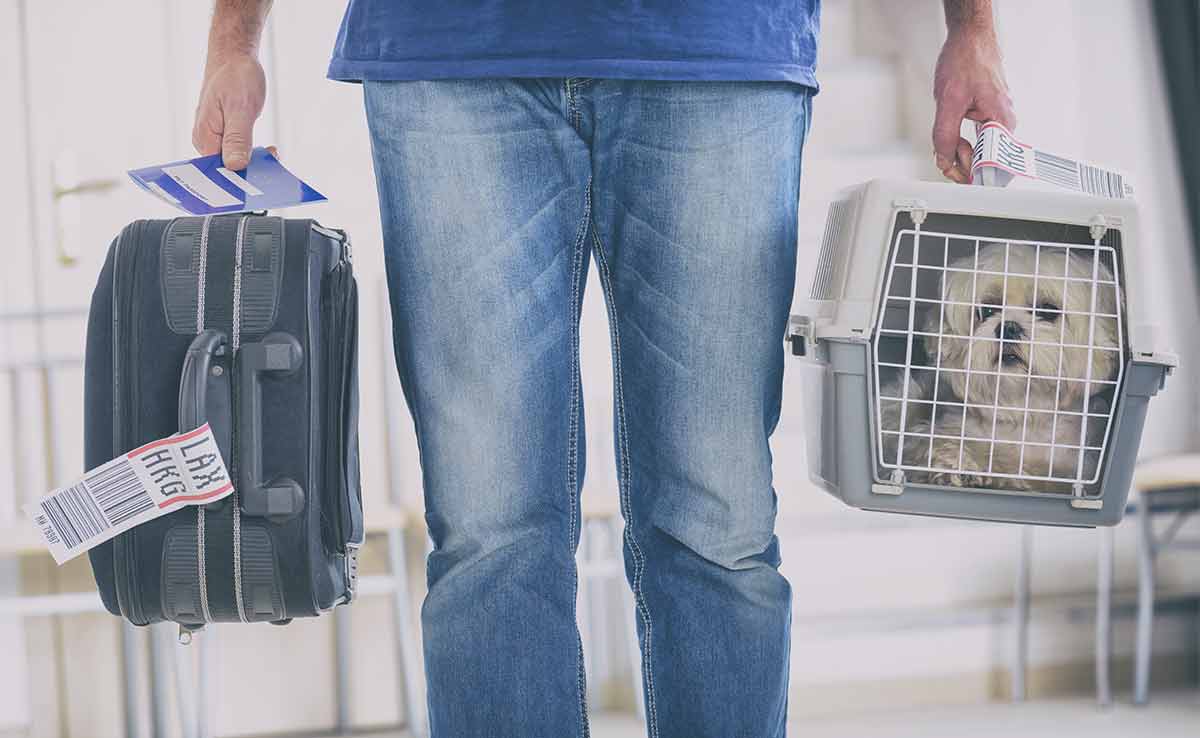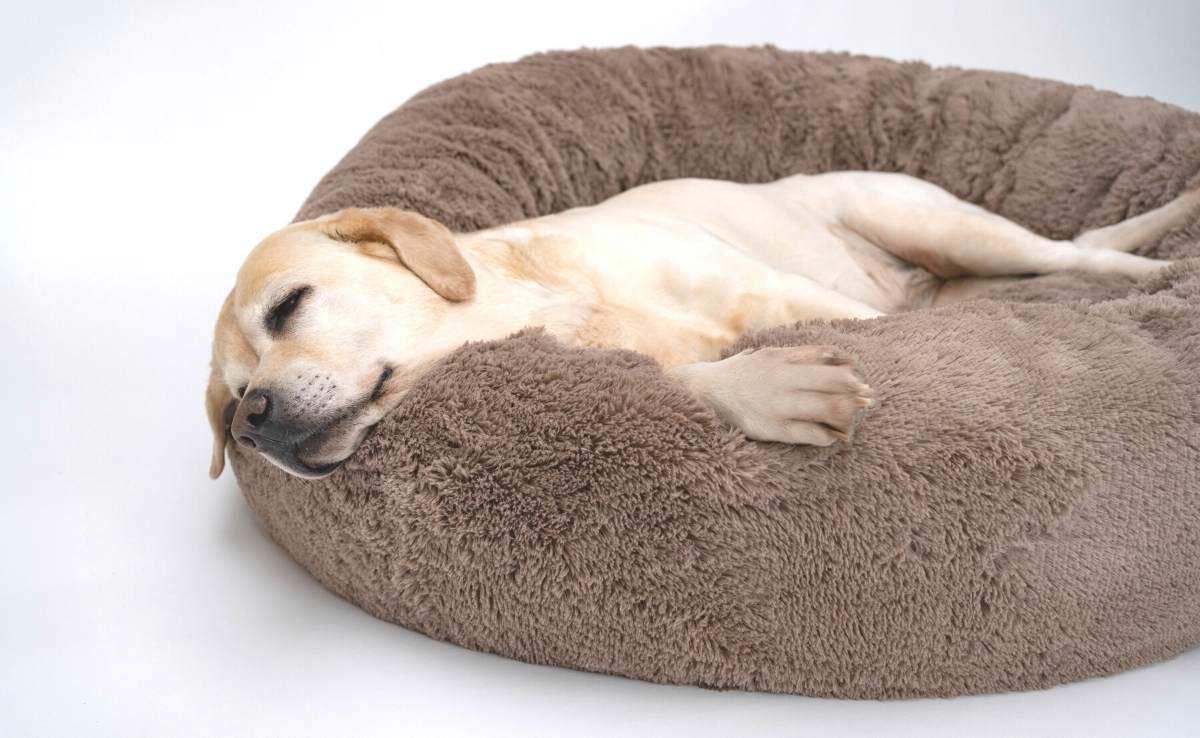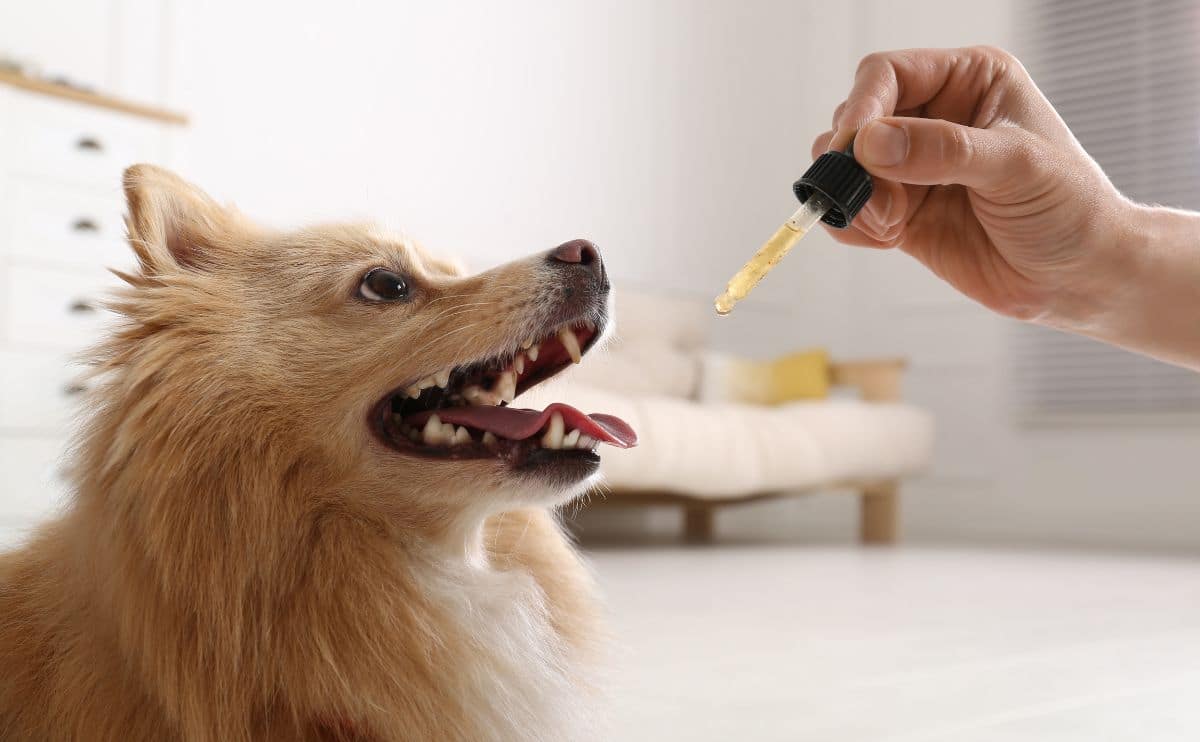Fireworks Freaking Out Your Dog? Here’s What Actually Helps
When you purchase through links on our site, we may earn a commission. Here’s how it works.
One loud boom and your pup is under the bed, shaking like a leaf. Fireworks might be fun for us, but to your dog, they sound like the end of the world.
Table of Contents
Why does it trigger such a strong reaction, and what can you do before the next big blast? Let’s get straight to it.
Why Fireworks Feel Like The Apocalypse To Dogs
It starts with one sharp crack in the sky. Within seconds, your dog is trembling under the bed, pacing the hallway, or trying to wedge themselves behind the toilet.
You can’t reason with that kind of fear because it’s not about logic. It’s sensory overload.
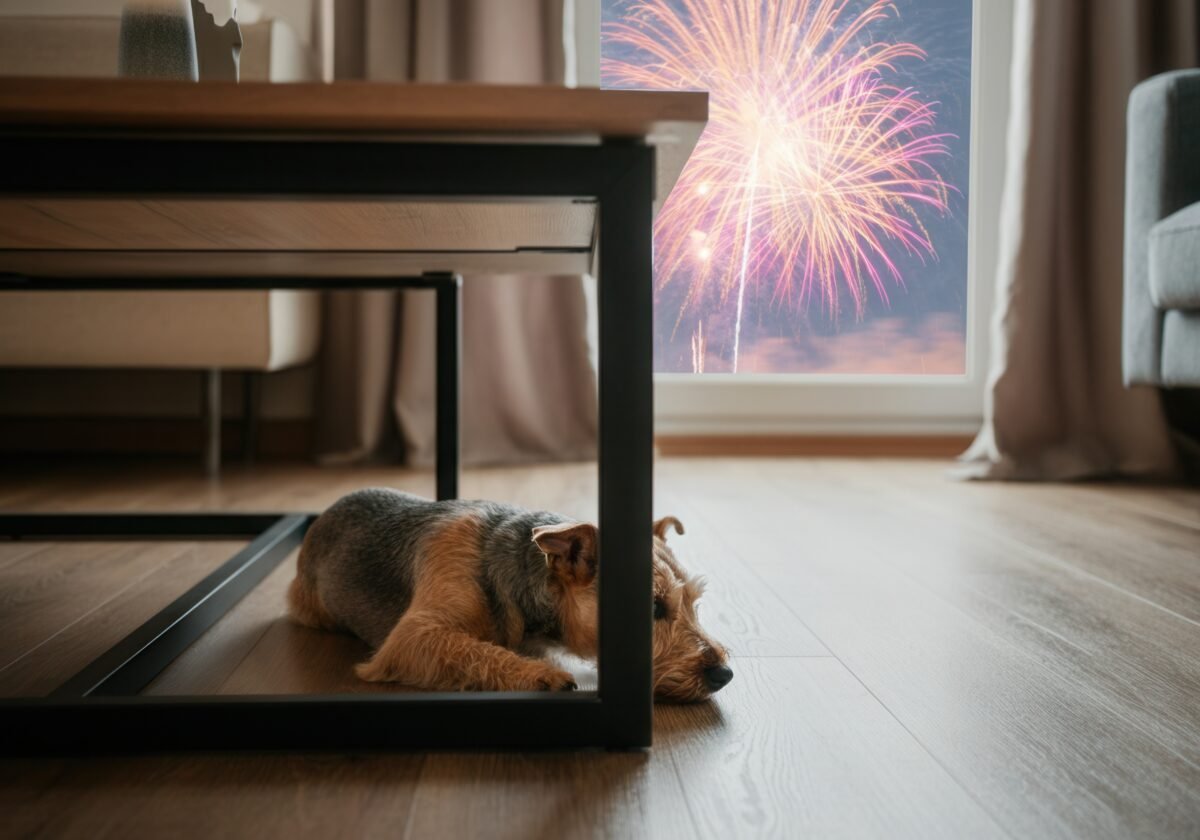
Fireworks hit multiple senses at once. Loud bangs, flashing lights, floor vibrations, and even unfamiliar smells arrive simultaneously. That combination is almost impossible for a dog to ignore or process calmly.
Dogs hear differently than humans. While we detect sounds up to about 20,000 hertz, dogs can hear pitches as high as 65,000 hertz.
They are especially sensitive between 3,000 and 12,000 hertz, where they can pick up sounds far below our threshold—sometimes as quiet as -15 decibels.
But fireworks are tricky. Most of their sound energy falls below 500 hertz. So dogs aren’t reacting to pitch alone.
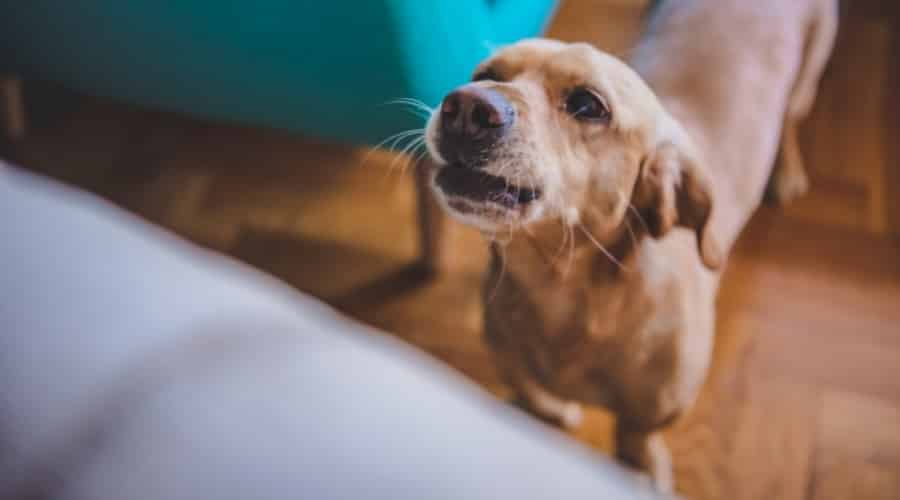
The real issue is the suddenness and extreme volume. Fireworks can reach 150 to 175 decibels, louder than a jackhammer, motorcycle, or jet engine at takeoff.
Now add the flashing lights and the physical sensation of pressure waves through the air. From a dog’s point of view, there is no context or source for these changes. It just starts, and the brain floods with alarm signals.
A large-scale survey found that more than 50 percent of dogs show signs of fear during fireworks. Some go on to develop long-term noise phobias that intensify with age and repeated exposure.
Quick takeaway: Fireworks don’t just startle dogs. They overwhelm them through sound, light, and vibration.
Our Personal Experience With A Firework-Fearing Dog
Every July, like clockwork, Daisy disappears.
The moment the first firework cracks in the sky, she vanishes. Not behind the couch. Not under the bed. She goes straight to the hallway closet, noses the door open, and burrows under a pile of blankets like she’s digging her way to another country.
I’ve tried everything—calming chews, classical music, a Thundershirt, even dog-calming YouTube videos with waterfall sounds. Nothing works once the booms start.
Last year, I found her wedged between a suitcase and a winter coat, wrapped in an old fleece blanket like a sad little burrito. Her ears were pinned back. Her eyes were wide. She looked at me like, “Why is the sky attacking us?”
I ended up sitting in the closet with her for an hour, gently petting her and whispering nonsense until the fireworks finally faded. She didn’t relax, but at least she stopped trembling.
It’s become our Fourth of July tradition. While the neighborhood lights up with celebration, we hide in the closet—just Daisy, me, and a heap of coats and unconditional love.
– Danielle DeGroot, Daisy’s Owner & Canine Journal Writer
The Fireworks Survival Checklist (For You & Your Dog)
You don’t need a panic room or a prescription to help your dog through fireworks season. A few simple changes to your routine can make a big difference.
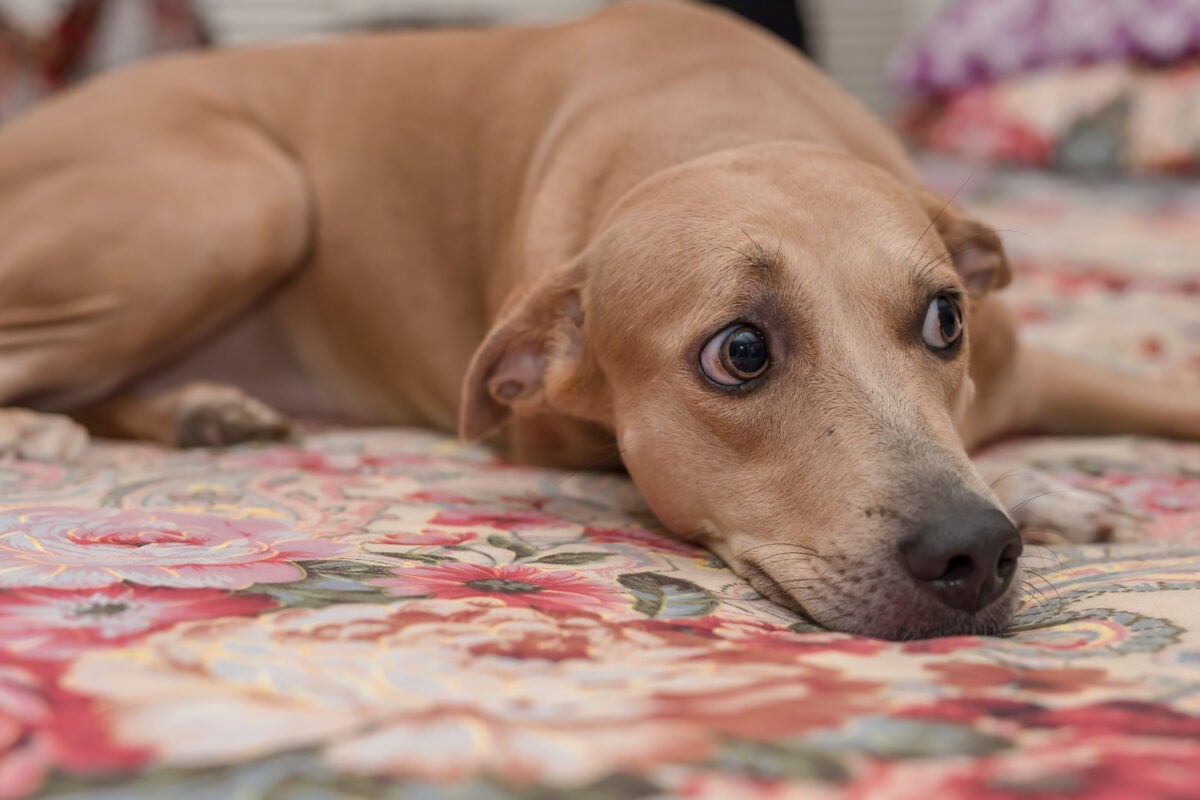
Start early, stay calm, and set your dog up for success.
Before The Fireworks Start
- Take a long walk to burn off excess energy
- Offer an early potty break to avoid accidents later
- Close all windows, curtains, and blinds
- Set up a quiet retreat space with blankets, a relaxing bed, or a covered crate
- Turn on calming music, white noise, or the TV
- Prepare puzzle toys, frozen Kongs, or lick mats for distraction
- Have calming products on hand (CBD treats, anxiety chews, compression vests)
During The Fireworks
- Stay calm and act normal—your dog takes cues from you
- Let your dog hide if they want to
- Don’t scold barking, whining, or pacing
- Avoid pulling them out of their hiding place
- Use a soothing voice or light petting only if your dog seeks it out
- Redirect with enrichment toys or a treat if they’re willing to engage
Quick Tip: A frozen peanut butter Kong can outlast a fireworks show and help your dog stay focused on something positive.
What Not To Do During Fireworks
Even with the best setup, your dog might still panic. That’s normal. But some well-meaning responses can make things worse.
Avoid These Common Mistakes
- Don’t scold or punish: Reacting with frustration only adds stress and confusion. Your dog isn’t misbehaving—they’re scared.
- Don’t force them to “face their fear”: Exposure doesn’t help if your dog is already overwhelmed. Forcing them to stay outside or near windows can make anxiety worse.
- Don’t drag them out of hiding: If they retreat to a bathroom, closet, or crate, let them stay. Hiding helps them feel safe.
- Don’t ignore signs of distress: Shaking, drooling, pacing, and barking are signals your dog is struggling. Offer support in a calm, quiet way.
- Don’t assume they’ll grow out of it: Noise anxiety often worsens over time. Early intervention is key to preventing long-term phobias.
The goal isn’t to “toughen up” your dog. It’s to help them feel secure during a chaotic event.
Are Some Breeds More Sensitive To Fireworks?
Yes. While any dog can panic during fireworks, some breeds are simply wired to be more reactive to loud, sudden sounds.
Breed traits like high alertness, strong attachment, or nervous energy can all play a role.
Herding Breeds
Examples: Border Collie, Australian Shepherd, German Shepherd
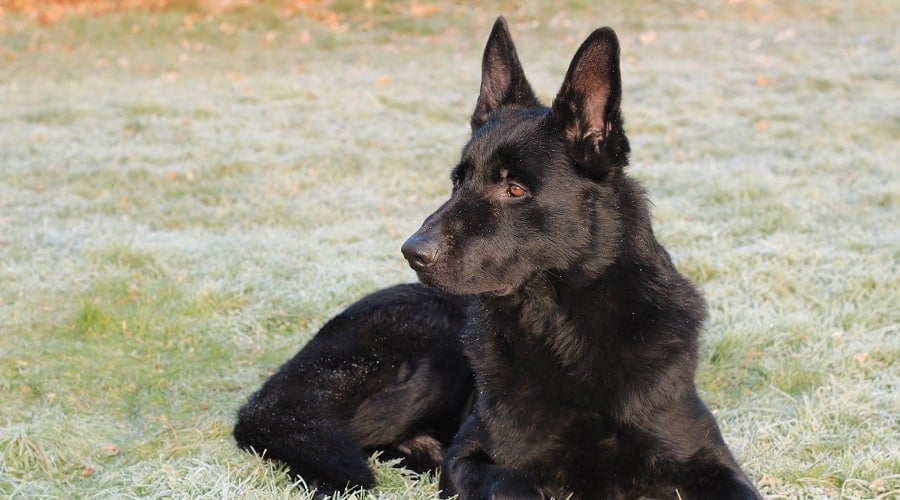
These dogs are bred to notice and respond to movement and noise quickly. Their sharp reflexes and strong problem-solving skills make them excellent workers, but they can also become overwhelmed when they can’t “fix” the chaos of a fireworks show.
Small Dogs
Examples: Chihuahua, Yorkshire Terrier, Toy Poodle

Small breeds often feel more vulnerable in general, and loud noises can feel physically overwhelming to a little body. Some have also been bred to be alert and yappy, which means they’re quick to respond with barking or pacing when startled.
Guarding Breeds
Examples: Doberman Pinscher, Rottweiler, Belgian Malinois
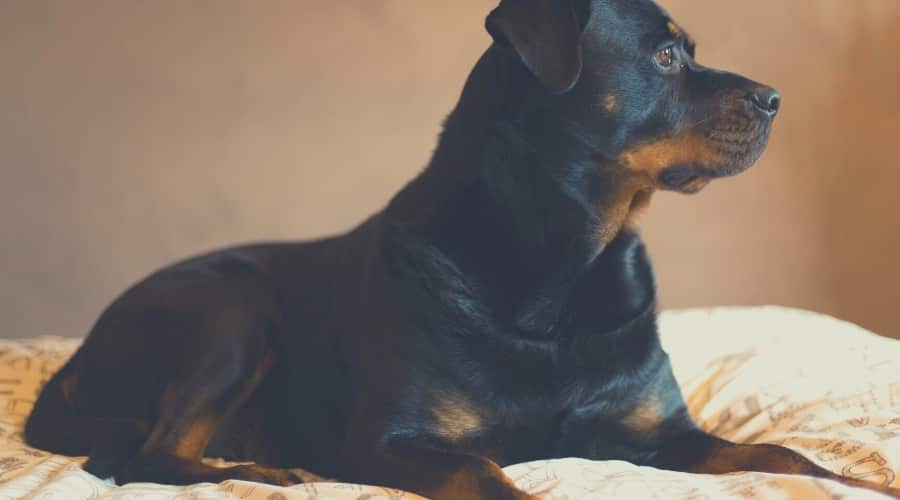
Protective breeds are tuned in to anything unusual in their environment. Fireworks can trigger their guarding instincts, causing them to become hyper-alert or agitated, even when there’s no real threat they can target.
Anxious Breeds
Examples: Greyhound, Whippet, many rescue mixes
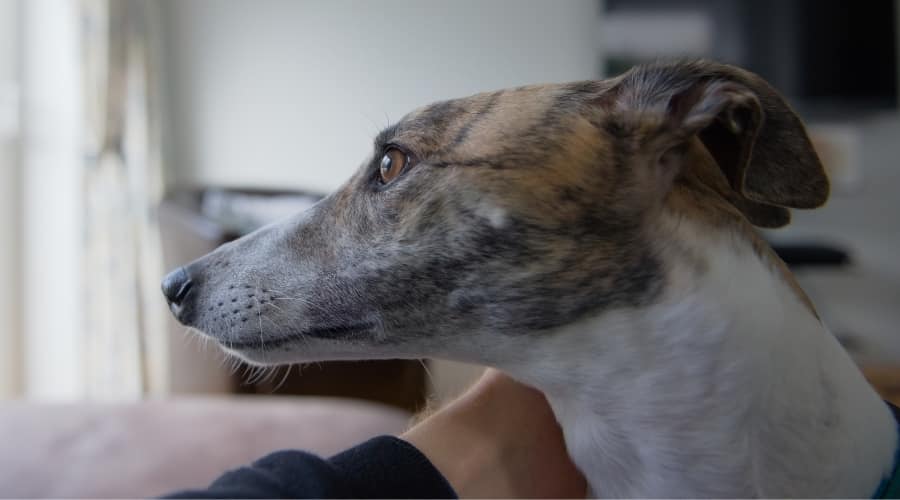
Some breeds are naturally more timid or sensitive to changes in the environment. Dogs who have had unstable pasts—such as rescues with unknown trauma histories—may also be more prone to sound-based panic, regardless of breed.
Note: Even dogs without these breed traits can develop firework anxiety. Past experiences, age, and socialization all matter. Knowing your dog’s triggers is more important than the breed label.
Create A Zen Den In Two Minutes Or Less
Building a calm retreat for your dog doesn’t require special gear or hours of effort. This simple setup can dramatically reduce stress during fireworks, and you can do it in minutes.
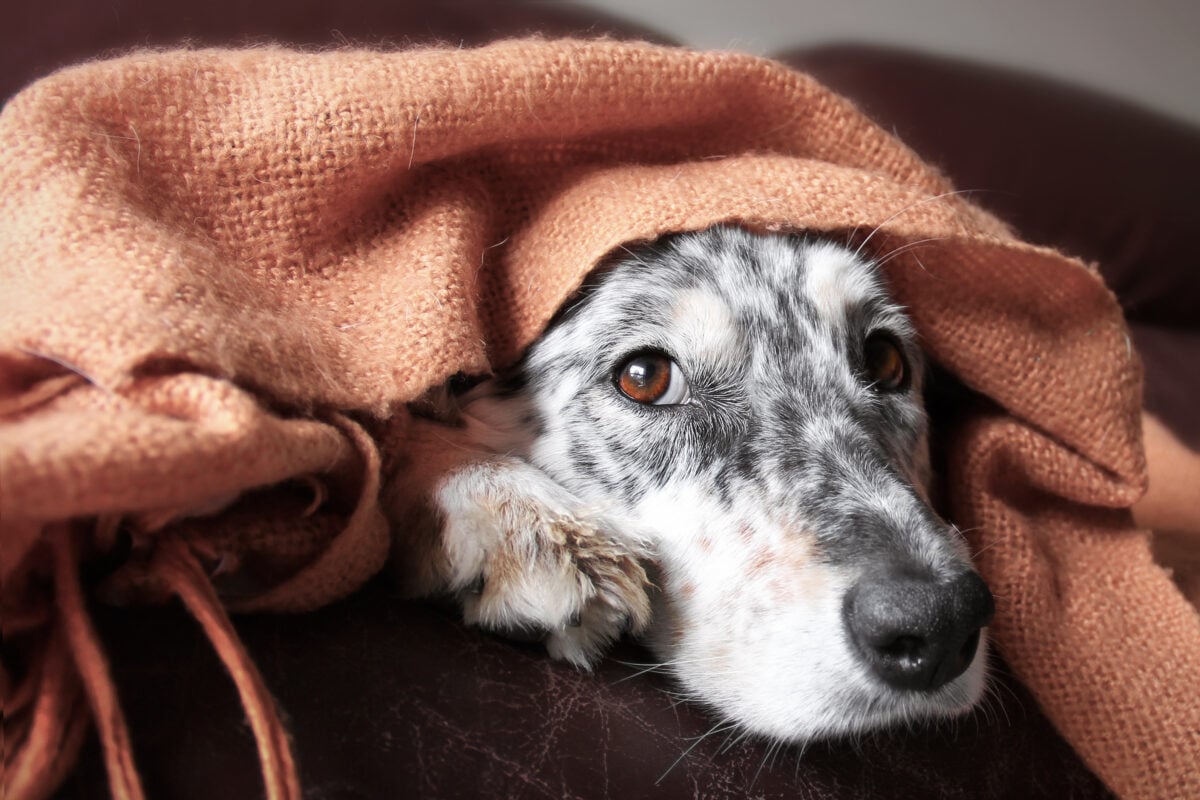
Quick Calm Checklist
A cozy, covered retreat with soft sounds and familiar items can dramatically reduce your pup’s anxiety.
1. Pick A Sheltered Location
- Choose a small room or closet away from windows.
- Avoid areas with flashing lights or echoes.
2. Add Soft Bedding
- Use fluffy blankets or a favorite bed.
- Drape a sheet or towel over a crate to mute sound and light.
3. Block Out Noise
- Close windows and draw curtains.
- Layer towels or cushions along doors for sound dampening.
4. Introduce Calming Sound
- Play soft music, TV, or a white-noise track at low volume.
- Aim for a consistent background hum—not spikes.
5. Include Familiar Items
- Add favorite toys, an old t-shirt with your scent or a chew treat.
- Familiar smells and textures reduce anxiety.
6. Keep Lighting Gentle
- Use dim lighting or leave a hallway light on.
- Avoid bright lamps that might aggravate your dog.
Thundershirts, CBD & Other Calming Products: What Actually Helps?
Some dogs need more than a quiet space. These calming tools can take the edge off fireworks panic, but results vary, and it’s best to test them before the big show.
Compression Vests
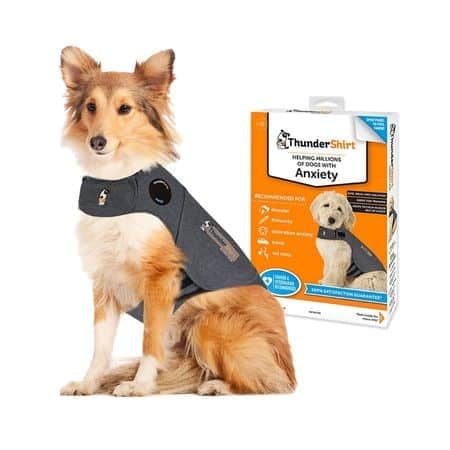
Compression vests apply gentle, consistent pressure around your dog’s torso, which can help reduce stress by promoting a sense of security. The idea is similar to swaddling a baby or using a weighted blanket.
One of the most popular options is the Thundershirt, which has been widely used for dogs with anxiety related to fireworks, storms, travel, and other stressors. Many owners report that their dog becomes noticeably calmer once the vest is on, especially when paired with a safe space or calming routine.
Use the vest during practice sessions before fireworks begins so your dog doesn’t associate it only with stress.
Best for: Dogs who seek pressure, touch, or hiding places when anxious.
Calming Chews & Supplements
These products use natural ingredients like L-theanine, tryptophan, valerian root, melatonin, and more to help reduce anxiety. Some are fast-acting and can be given 30 to 60 minutes before fireworks begin. Others work best when used daily in the days leading up to a known stress event.
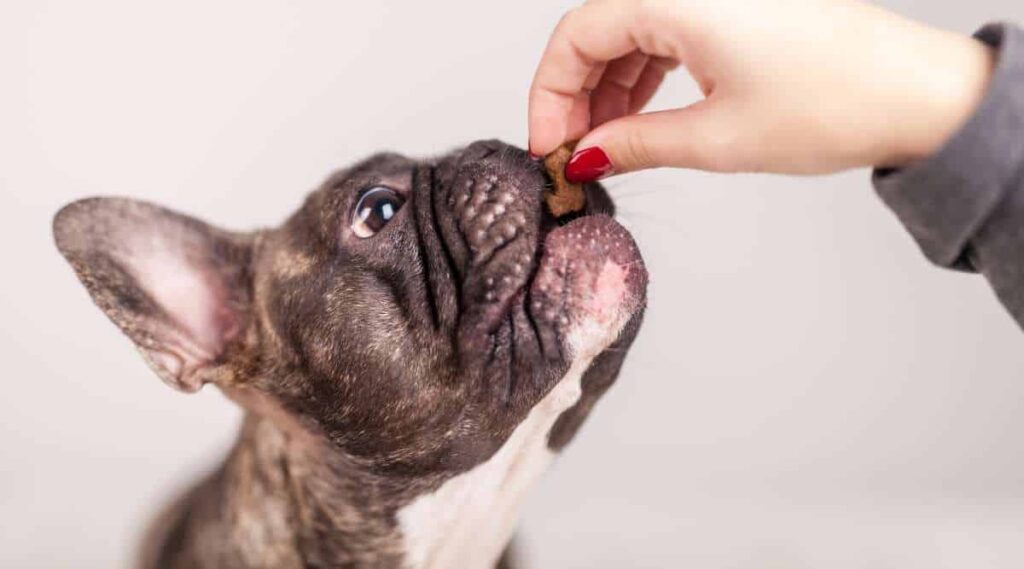
Bach’s Rescue Remedy for Pets is a popular option for holistic support. Made from flower essences and free from alcohol, it can be added to your dog’s water or food or given directly. Many owners use it as a gentle, natural calming aid.
Another great choice is Composure Calming Treats by VetriScience. These vet-recommended chews are available over the counter and often suggested for dogs with mild to moderate noise sensitivity. They contain a blend of ingredients that support relaxation without causing sedation.
For more product options, check out our full roundup of the best calming dog treats, including vet-approved formulas and soft chews with thousands of positive reviews.
These supplements may not eliminate anxiety entirely, but they can take the edge off and make other calming strategies more effective.
Best for: Dogs with mild-to-moderate fireworks anxiety, or as part of a layered plan that includes calming spaces or compression gear.
CBD Oils & Treats
CBD (cannabidiol) has become one of the most talked-about options for calming dogs during fireworks and other stressful events. While studies are ongoing, many pet owners report that their dogs are noticeably less reactive to noise and more relaxed after using CBD.
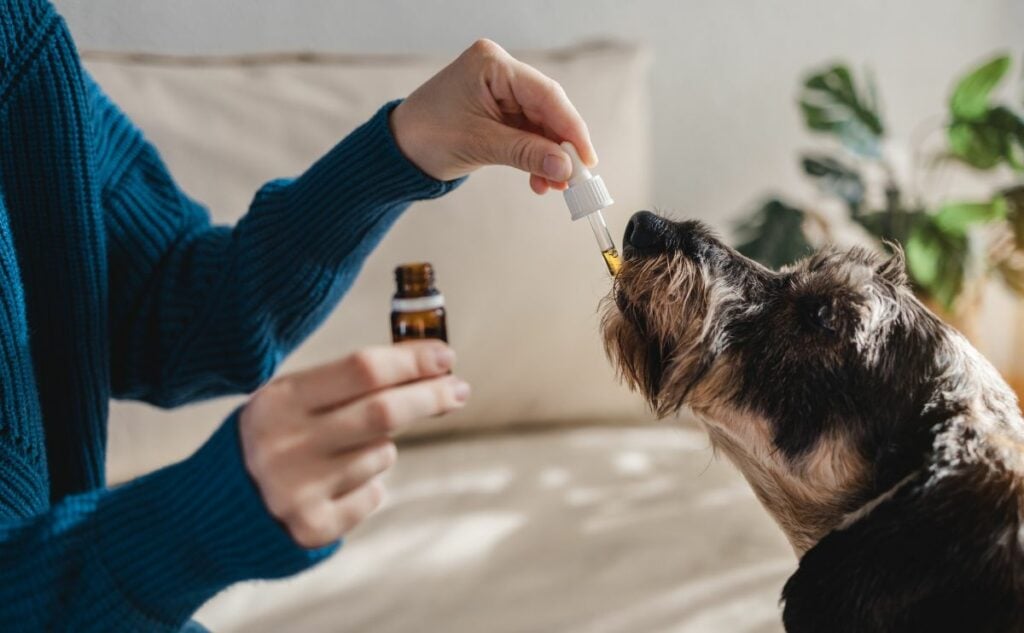
CBD is thought to interact with your dog’s endocannabinoid system, which helps regulate mood, stress, and anxiety. It is not psychoactive and won’t make your dog feel “high.”
CBD comes in several forms:
- Oils and tinctures, which can be added to food or given directly
- Pre-dosed treats, chews, or calming bites
- Subscription boxes for ongoing use
If you’re new to CBD, start with this guide to the benefits of CBD for dogs, or check out our full breakdown of the best CBD oils and brands for dogs. Proper dosing is key, so be sure to consult our CBD dosage chart for dogs based on weight and sensitivity.
Looking for a treat-based option? We’ve tested and reviewed the best CBD dog treats for anxiety, mobility, and general wellness. If you’re using CBD regularly, you might also consider a CBD subscription box for dogs to make restocking easier.
Choose high-quality, pet-specific products from companies that use third-party testing. Always start with the lowest effective dose and monitor how your dog responds.
Best for: Dogs with moderate to severe noise anxiety or those who don’t respond well to other calming tools.
Pheromone Sprays & Diffusers
Dog-appeasing pheromones (DAP) mimic the scent a mother dog releases to calm her puppies. These can be delivered through collars, room diffusers, or sprays applied to bedding or crates.
While results are subtle, some dogs seem noticeably more relaxed with pheromones in the environment.
Best for: Dogs who respond to scent cues or struggle to settle in their safe space.
Aromatherapy
Certain scents may have a calming effect on dogs, especially when used appropriately. Among the most studied is lavender.
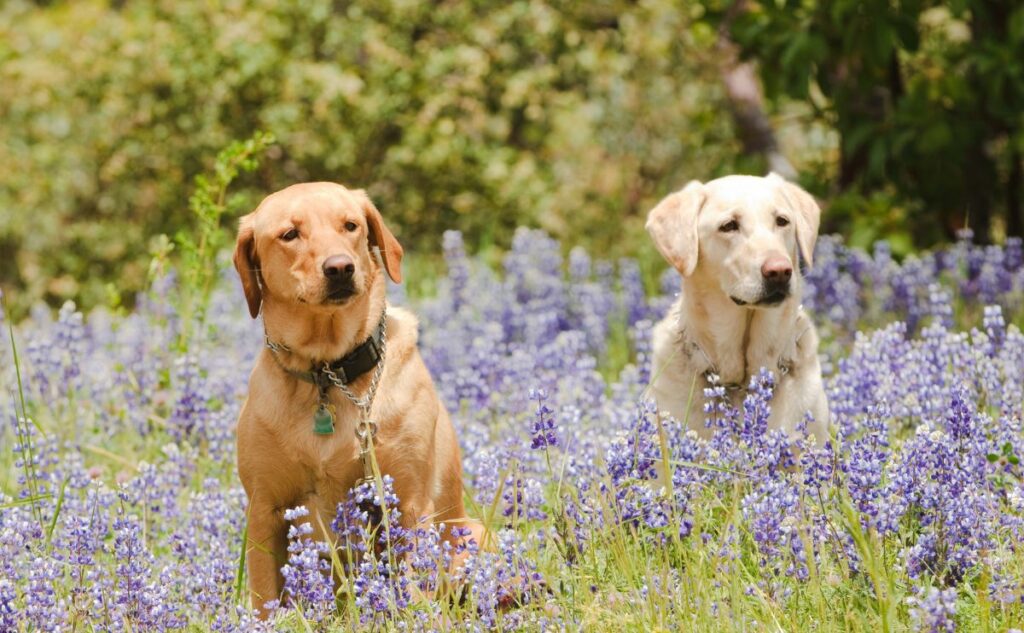
A 2006 study published in the Journal of the American Veterinary Medical Association found that dogs exposed to lavender scent during car rides showed significantly reduced signs of travel-induced excitement.
A 2021 study published in the American Journal of Veterinary Research found that lavender oil produced mild vagal activity in dogs, which supports the idea that it may help trigger a relaxation response.
For safety, always use pet-safe, diluted essential oils in a well-ventilated room. A few drops in a diffuser placed outside your dog’s immediate resting area is best. Avoid direct application to your dog’s skin or coat, and never use strong essential oils in enclosed spaces.
Not a fan of DIY? Lavender is commonly used in calming sprays or essential oil blends marketed for pets.
Best for: Dogs who respond to scent cues or spend time in a designated safe space where calming routines are in place.
Music For Dogs
Music can do more than mask fireworks. Several studies suggest that classical music, in particular, can help reduce stress behaviors in dogs, especially in high-stimulation or confined environments.
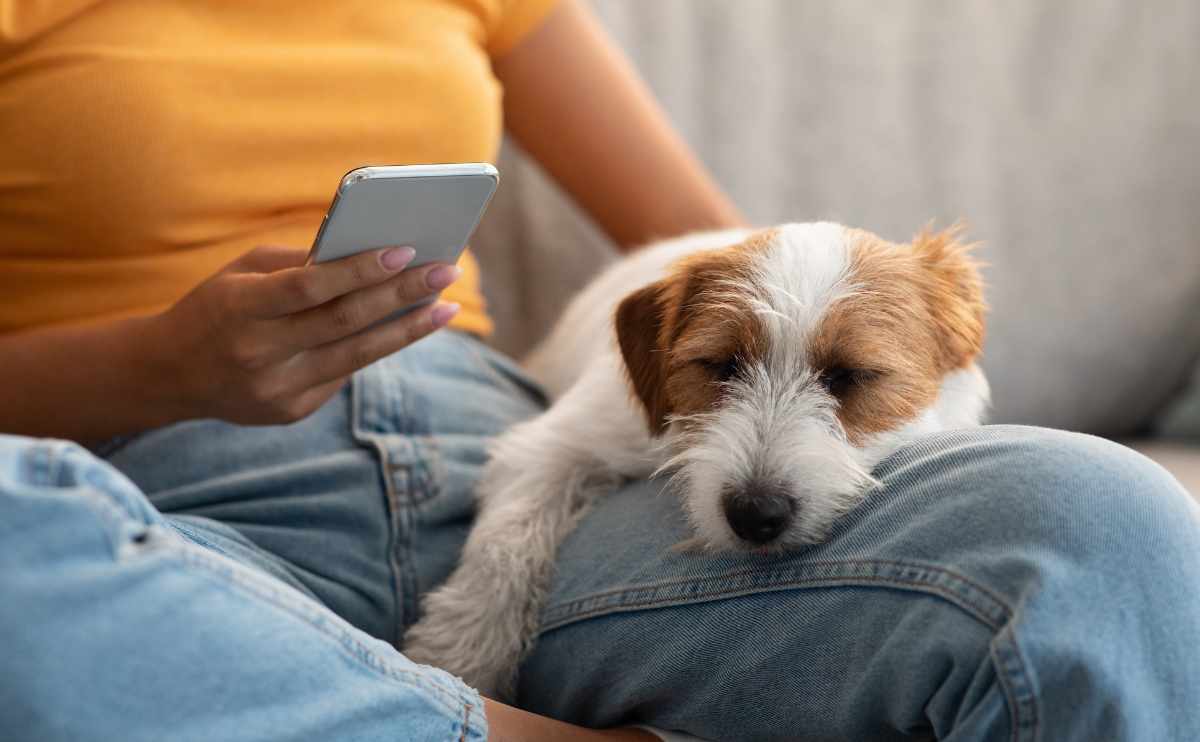
A review in Animals concluded that classical music is generally associated with lower stress indicators in dogs, especially when compared to silence or harsher sound environments.
A 2023 study exploring the behavior of dogs in shelter settings found that classical music increased resting and reduced barking. Conversely, heavy metal significantly increased vocalization and agitation.
In another study of kenneled dogs, researchers observed that dogs displayed more relaxed behaviors when exposed to classical music. The effect faded after repeated exposure, so variety is key for maintaining results.
Interestingly, not all calming tracks are equally effective. A 2020 study found that low-pitched music may increase alertness in some dogs, highlighting the importance of song selection and individual response.
Fun Fact: Mozart vs Chopin
In a 2023 study on dogs undergoing sedation, researchers found that Mozart’s Sonata for Two Pianos in D major, K.448 reduced the amount of sedative needed more than Chopin’s Nocturne in D-flat major.
Why might Mozart be more effective?
- The steady rhythm of Mozart K.448 may better support neural relaxation.
- The piece has also been studied in humans for its calming and seizure-reducing effects.
- Chopin’s emotive and fluid melodies are beautiful—but possibly less predictable to the brain.
What to try:
- Classical playlists that include Mozart, harp, or acoustic guitar
- Canine-specific music like “Through a Dog’s Ear”
- Avoid heavy metal or high-arousal pop
- Rotate playlists every few days to prevent habituation
Best for: Dogs who are sensitive to unpredictable outdoor sounds and benefit from consistent, calming background noise.
Prescription Options
If your dog still panics during fireworks despite trying vests, treats, music, or scent cues, it may be time to talk to your vet about medication.

For some dogs, anxiety during fireworks is so severe that it interferes with sleep, safety, or daily behavior. In those cases, prescription support can make a dramatic difference.
Commonly prescribed options include:
- Sileo (dexmedetomidine oral gel) – an FDA-approved medication for noise aversion that’s fast-acting and easy to apply between the cheek and gum
- Trazodone – an oral medication often used situationally to reduce anxiety
- Gabapentin – sometimes used in combination with other medications for its calming and mild sedative effects
Some dogs benefit from one medication given shortly before fireworks. Others may need a layered approach that includes daily anti-anxiety support during the season.
What To Expect
- Most meds work best when trialed in advance of fireworks night
- Your vet will likely recommend a test run in a calm setting first
- Talk to your vet about side effects, which may include drowsiness or disorientation
Quick takeaway: Prescription meds aren’t a last resort. They’re a compassionate option for dogs who need extra help feeling safe when the world outside feels chaotic.
Our Personal Experience: When Nothing Works
My pup, Tiny, has major anxiety with loud noises, especially thunderstorms, which are so common here in the southeast. But when fireworks happen, it’s just as bad.
I’ve tried CBD, calming supplements, and all other non-prescription “meds” for him to help manage his anxiety during fireworks season (and thunderstorms).
No “meds” I’ve tried work. All I can do is turn the music or TV up loud in my house and hold him close to me so he feels safe with the loud noises.
– Sally Jones, Tiny’s Owner & Canine Journal Writer
Fireworks Without The Boom? Yes, They Exist
Not all fireworks have to come with a side of panic.
In recent years, many towns and cities have started using quiet fireworks—visual displays that offer the same sparkle and color without the thunderous explosions.
These low-noise alternatives reduce the sharp bangs and booms that trigger anxiety in dogs, people with PTSD, and young children. Instead of explosive charges, they rely on low-decibel effects like crackling, shimmering, or silent aerial patterns.
Where it’s catching on:
- Several towns in Italy have passed laws requiring low-noise fireworks
- Communities in the UK and Canada have started offering silent displays during holidays
- Some U.S. cities are experimenting with quiet shows at pet-friendly events
You can’t control your neighbor’s backyard display, but you can advocate for quiet alternatives through your local parks department, city council, or neighborhood association.
Some pet owners have even hosted backyard light shows with drones or LED projectors as a noise-free substitute.
When To Seek Professional Help
If your dog doesn’t just get anxious but shows signs of noise phobia, it’s time to bring in expert support.
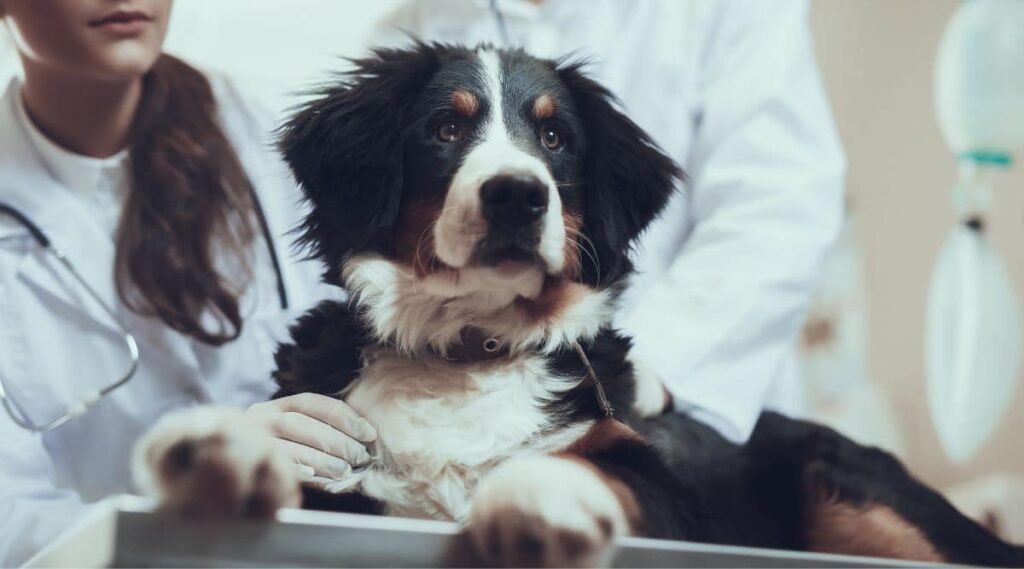
A noise phobia goes beyond temporary fear. It’s an intense, often escalating reaction that can affect your dog’s health, safety, and quality of life.
What does noise phobia look like?
- Bolting, trying to escape confinement, or destructive digging
- Shaking uncontrollably or hiding for hours
- Drooling, panting, or vocalizing with no sign of calming down
- Refusing to eat, drink, or go outside—even after the noise stops
Dogs with phobias often react not just to fireworks but to thunder, construction, or even TV sound effects. Without intervention, these reactions tend to worsen over time.
In these cases, working with a certified veterinary behaviorist or fear-free trainer can make a real difference. Desensitization programs, paired with counter-conditioning and medical support, can help rewire your dog’s response to sound.
Your vet may also recommend:
- Daily anti-anxiety medication during fireworks season
- Situational meds used only during noise events
- A structured behavioral plan tailored to your dog’s triggers
Quick takeaway: If your dog’s response to fireworks feels extreme, it probably is. Phobias are real, treatable conditions—and you don’t have to manage them alone.
Frequently Asked Questions
Dogs don’t all respond to fireworks the same way. These common questions can help you better understand what’s normal, what’s not, and what to do when your dog seems overwhelmed.
Don’t see yours? Ask us in the comments!
How Long Do Fireworks Affect Dogs?
Some dogs bounce back quickly once the noise ends. Others may stay anxious for hours or even days, especially if fireworks continue multiple nights in a row.
Should I Comfort My Dog During Fireworks, Or Will That Reinforce Fear?
You can’t reinforce fear by being kind. If your dog seeks contact, staying nearby and speaking calmly is okay. Just don’t overreact or force attention if they prefer space.
Do Dogs Grow Out Of Firework Anxiety?
Most do not. Fireworks anxiety often gets worse over time without support. Early intervention gives you the best chance of preventing long-term stress.
Is It Safe To Give My Dog Benadryl?
Some vets use Benadryl for mild anxiety, but it’s not ideal for fireworks. It may make your dog drowsy without reducing fear.
Always ask your vet before giving any medication.
What’s The Best Calming Aid For Dogs During Fireworks?
That depends on your dog’s needs. CBD, calming chews, pheromones, vests, and music can all help. Many dogs respond best to a layered plan rather than just one tool.
When Should I Talk To My Vet?
Talk to your vet if your dog panics, refuses to eat or go outside, or doesn’t calm down after the fireworks. These may be signs of noise phobia.
A professional can help you build a plan that works.
Need More Help Calming Your Dog?
Fireworks aren’t the only trigger for canine anxiety. Learn more about how to help dogs with anxiety and calm the excessive barking that may occur during periods of stress.
